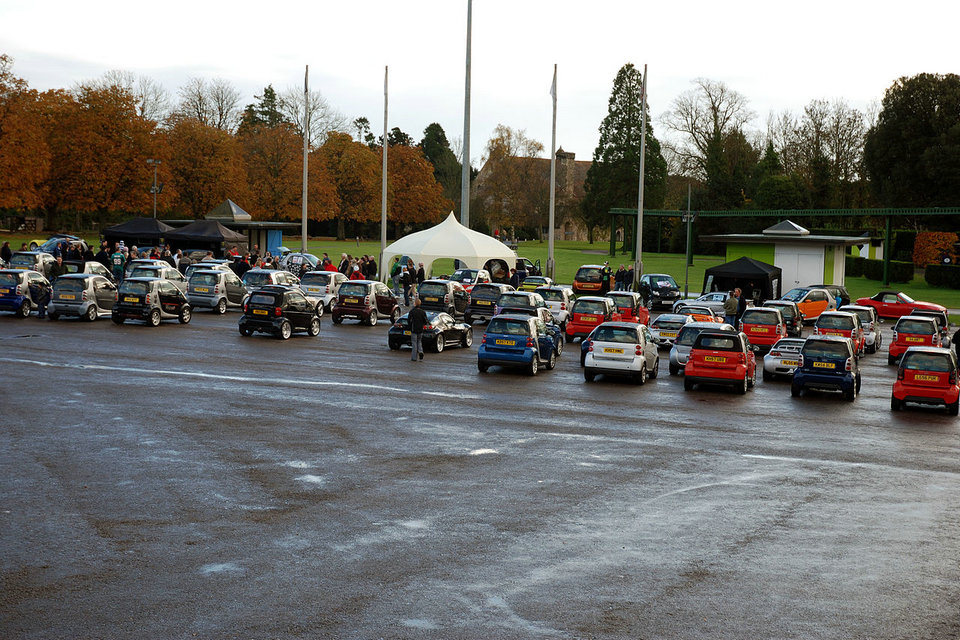Platoon of smart cars


Grouping vehicles into platoons is a method of increasing the capacity of roads. An automated highway system is a proposed technology for doing this.
Platoons decrease the distances between cars or trucks using electronic, and possibly mechanical, coupling. This capability would allow many cars or trucks to accelerate or brake simultaneously. This system also allows for a closer headway between vehicles by eliminating reacting distance needed for human reaction.
Platoon capability might require buying new vehicles, or it may be something that can be retrofitted. Drivers would probably need a special license endorsement on account of the new skills required and the added responsibility when driving in the lead.
Smart cars with artificial intelligence could automatically join and leave platoons. The automated highway system is a proposal for one such system, where cars organise themselves into platoons of 8 to 25.
Potential benefits
Greater fuel economy due to reduced air resistance.
Reduced congestion
Substantially shorter commutes during peak periods.
On longer highway trips, vehicles could be mostly unattended whilst in following mode.
Fewer traffic collisions
Potential disadvantages
Some systems have failed in traffic, as they have been hacked by remote computers, creating a hazardous situation.
Drivers would feel less in control of their own driving, being at the hands of computer software or the lead driver.
Drivers may be less attentive than usual, and they may not be able to react as quickly to adverse situations if the software or hardware were to fail.
Automated highway system
An automated highway system (AHS) or Smart Road is a proposed intelligent transportation system technology designed to provide for driverless cars on specific rights-of-way. It is most often recommended as a means of traffic congestion relief, on the grounds that it would drastically reduce following distances and headway, thus allowing a given stretch of road to carry more cars.
How it works
In one scheme, the roadway has magnetized stainless-steel spikes driven one meter apart in its center. The car senses the spikes to measure its speed and locate the center of the lane. Furthermore, the spikes can have either magnetic north or magnetic south facing up. The roadway thus provides small amounts of digital data describing interchanges, recommended speeds, etc.
The cars have power steering and automatic speed controls, which are controlled by a computer.
The cars organize themselves into platoons of 8 to 25 cars. The cars within a platoon drive themselves a meter apart, so that air resistance is minimized. The distance between platoons is the conventional braking distance. If anything goes wrong, the maximum number of harmed cars should be one platoon.
An overview of platooning systems is given in Bergenhem et al.
Recently, platooning of trucks has been proposed as a concept to reduce the energy consumption of semi-trucks and improve the feasibility of electric semi-trucks.
Early development
The origin of research on AHS was done by a team from Ohio State University led by Dr. Robert E. Fenton, based on funding from the U.S. Federal Highway Administration. Their first automated vehicle was built in 1962, and is believed to be the first land vehicle to contain a computer. Steering, braking and speed were controlled through the onboard electronics, which filled the trunk, back seat and most of the front of the passenger side of the car. Research continued at OSU until federal funding was cut in the early 1980s.
Deployments
The USDOT-sponsored National Automated Highway System Consortium (NAHSC) project, a prototype automated highway system, was tested in San Diego County, California in 1997 along Interstate 15. However, despite the technical success of the program, investment has moved more toward autonomous intelligent vehicles rather than building specialized infrastructure. The AHS system places sensory technology in cars that can read passive road markings, and use radar and inter-car communications to make the cars organize themselves without the intervention of drivers. Such an autonomous cruise control system is being developed by Mercedes-Benz, BMW, Volkswagen and Toyota.
The Federal Highway Administration in 2013 funded two research projects in heavy truck platooning (without steering automation). One is led by Auburn University with Peterbilt, American Trucking Associations, Meritor Wabco, and Peloton Technology and the other is led by California Department of Transportation, with UC Berkeley and Volvo Trucks.
SARTRE
The SARTRE Project (Safe Road Trains for the Environment), is a European Commission funded project investigating implementation of platooning on unmodified European motorways. The project begun in September 2009, and vehicle platooning, as envisaged by the SARTRE project, is a convoy of vehicles in which a professional driver in a lead vehicle heads a line of closely following vehicles. Each following vehicle autonomously measures the distance, speed and direction and adjusts to the vehicle in front. Once in the platoon, drivers can do other things while the platoon proceeds towards its long-haul destination. All vehicles are detached and can leave the procession at any time.
In January 2011, SARTRE made the first successful demonstration of its platooning technology at the Volvo Proving Ground near Gothenburg, Sweden, in which a lead truck was followed by a car. In January 2012, SARTRE made a second demonstration in Barcelona, Spain, in which a lead truck was followed by three cars driven entirely autonomously at speeds of up to 90 km/h (56 mph) with a gap between of at most 6 m (20 ft). The companies that participated in SARTRE were Volvo Trucks and Volvo Car Corporation.
EU Truck Platooning Challenge
During its Presidency of the European Union in 2016, the Netherlands organised a European Truck Platooning Challenge. Six brands of automated trucks – DAF Trucks, Daimler Trucks, Iveco, MAN Truck & Bus , Scania AB and Volvo Trucks – ran on public roads from several European cities to the Netherlands.
Source from Wikipedia